One chance is all you need.
– Jesse Owens
Soon-to-be Berlin Marathon finishers stream through the Brandenburg Gate
(A BC&H early happy birthday to fellow scientist/runner/blogger Jen over at Running Tangents… I tried to take your blog title to heart in Berlin, I really did…)
Realization often strikes in retrospect. Sometimes, though, you know when you’re facing a moment of truth. With the Brandenburg Gate rising imposingly behind and the Victory Column looming straight ahead, the start line of the 41st Berlin Marathon felt like that moment.
In recent years, Berlin has achieved a singular level of cachet among hardcore runners. This is due in part to its status as one of the six World Marathon Majors, alongside Boston, Chicago, London, New York and Tokyo. That, and Berlin has practically become the home court of the world marathon record – prior to this year, the world record had been set in Berlin five times in the past eleven years, most recently in 2013 by Kenya’s Wilson Kipsang (2:03:23). Amateur runners from across the globe come each year to race Berlin’s famously flat and speedy course, and to check another World Marathon Major off their bucket list. For many of these runners, Berlin offers a golden opportunity to qualify for another celebrated six-letter marathon that starts with a ‘B’ and ends with an ‘N’.
Admittedly, this was my own rationale in designating Berlin as my target race for 2014. With all due respect to the granddaddy of all marathons in New York City (which I’ll be running next month), Berlin would offer me the best shot at setting a new PR and qualifying for Boston in 2016, when my age group qualifying time slows by ten minutes, from 3:15:00 to 3:25:00. Killing three birds with one stone, it would also represent my second World Marathon Major and third continent, alongside North America and Antarctica.
Berlin’s standing as one of the most historically and culturally relevant cities in the world (and sister city to our own L.A.) didn’t hurt my decision. And Katie, who’s always happy to use my running to advance her travel agenda, immediately and enthusiastically green-lit Berlin for 2014.
That was when the race organizers launched Operation: Buzzkill, a.k.a. the Berlin Marathon lottery.
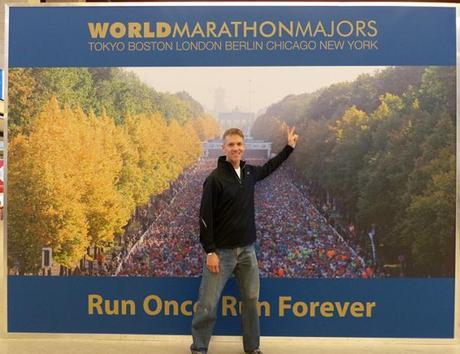
Peace, Berlin! And thanks for being my second World Marathon Major
Granted it came as no surprise… Berlin was the last of the World Marathon Majors to move to a lottery (or in the case of Boston, qualifying) system, wherein interested runners submit their name in the hopes of being chosen at random to participate in the race. But its “overdue and imminent” status didn’t make the institution of a lottery any less frustrating, particularly since several of us had already made plans to run Berlin this year. So when none of our names were among those chosen from the pool of 74,707 applicants, two of my friends opted to head for the wine country and run the Donostia-San Sebastian Marathon in Spain instead.
With my head and heart still set on Berlin, Katie and I decided to hitch a ride with our friends at Marathon Tours & Travel, with whom we’d traveled to Antarctica and who offer packages (including race entry) for the Berlin Marathon. And I persuaded myself that bypassing the frustration of future lottery selections would be well worth the added expense. Besides, I’ll still have the fun of the London, Tokyo and potentially Boston lotteries to look forward to, with others sure to follow.
Let him that would move the world first move himself. – Socrates
I’d positioned myself at the front of the start corral, and as the official starter’s countdown hit zero I surged forward toward the Siegessäule (Victory Column) 600 yards ahead. Immediately I found myself running in open space. Adrenalized runners shot by me like cartoon Road Runners {meep meep!}, and despite my brain’s protests I dialed back my own effort to avoid the hair-on-fire mistake of going out too fast. I had no way of knowing that in contrast to every other race I’ve ever run, those first 600 yards would be the least congested part of the course.
Also unlike other races I’ve run, I’m pretty sure this was the first time I’d seen not one but two runners smoking in the staging area before a race. I tried to get a photo of the first one with cigarette in hand and bib number in place, but he jumped up to embrace a group of friends before I could reach my camera. And I noticed the second fellow after I’d already conceded my drop bag, when he dropped his cigarette butt on the sidewalk, stamped it out and ran to join his corral at the start line. Probably beat me to the finish, too.
But the most important difference between Berlin and all the other races I’ve run, was that I’d arrived in the Tiergarten on Sunday to do just one thing: run. We’d allowed time before and after the race for exploring the city, so I had every intention of running as hard as I could until either I reached the finish line or my race ended otherwise in less storybook fashion. So I didn’t pay nearly the attention I normally would to what was going on around me, though if you think that will make this race report any shorter, well…
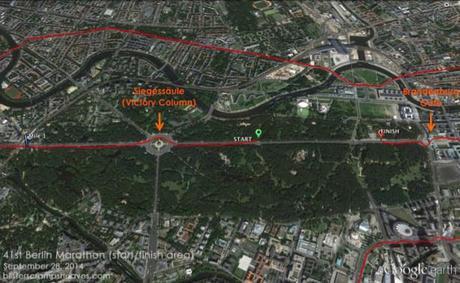
The start/finish area in the Tiergarten… the Victory Column and Brandenburg Gate are labeled in orange
Berlin is like being abroad in Germany. It’s German, but not provincial. – Claudia Schiffer
After arriving on Thursday evening, Friday began with a bus tour of the city organized by Marathon Tours. I’m not a big “bus tour” guy, generally preferring to wander and explore new cities on my own. But this turned out to be an excellent intro to Berlin courtesy of Matt, our British expat guide. He admitted that Berlin’s sordid role in recent world history is “nearly impossible to avoid,” and stressed that the city “approaches its history in a very open, honest, responsible way”. And he taught us much more about his adopted home than I could have learned on my own in the same amount of time.
Among the highlights of our 4+ hour tour, we learned:
- Berlin was built on swampland, and above-ground pipe networks were established to pump groundwater away from construction sites. These pipes – pink in some places, blue in others – are evident throughout the city, in some cases spanning intersections with no nod to aesthetic subtlety.
- Memorials to the victims of Nazi genocide have been erected in and around the Tiergarten, including discrete monuments to the Jewish, homosexual, parliamentary and Sinti and Roma (gypsy) victims of National Socialism. In particular, the Berlin Holocaust Memorial (Memorial to the Murdered Jews of Europe) contains 2,711 concrete slabs of varying size and height, arranged in a grid-like pattern on variably uneven ground to convey a sense of unease. Lending a grim irony to the adage “business is business,” the same company that produces the graffiti-resistant coating used to prevent neo-Nazi vandalism to the Memorial once manufactured Zyklon B, the cyanide-based pesticide used in the gas chambers of the Nazi concentration camps during World War II.
- The Berlin Wall (actually two walls fortified by a series of trenches and electrified fences, all patrolled by armed guards with attack dogs) was actually constructed around the perimeter of West Berlin. So in their zeal to prevent East Berliners from escaping, the Soviets effectively encircled the free half of the city with their Wall.
- No official signage marks the site of Adolf Hitler’s death, as nearly 70 years later German officials still fear it becoming a shrine for neo-Nazi groups.
- A staged Soviet propaganda photo of soldiers raising the Soviet flag over the Reichstag (German Parliament Building) in May 1945 had to be altered before its release because one of the soldiers could clearly be seen wearing a wristwatch on each arm, suggesting that he’d been looting.
- The city is 60 billion Euros (roughly $75 billion) in debt.
Berlin illustrated (clockwise from upper left): Charlottenburg Palace, 17th-century palace commissioned by the wife of Friedrich III; “Inferno”, sculpture created for the Dachau concentration camp and now on display in the German History Museum; the unsettling Memorial to the Murdered Jews of Europe; the German flag flies high over the Reichstag; Olympiastadion, site of Jesse Owens’ triumphant 1936 Olympic Games; modern-day remnants of Checkpoint Charlie, primary gateway between East and West Berlin during the Cold War; Memorial to the Murdered Members of the Reichstag; still-standing stretch of the Berlin Wall near the site of the former Gestapo headquarters; Brandenburg Gate
The tour bus then dropped us off at the marathon expo, held in the former Berlin Tempelhof Airport. For any of us paying attention, the fact that the race expo was held in a former airport should have been an ominous sign – turns out it was a bloated monstrosity, filling several hangars of the airport and making the 2012 Chicago Marathon expo, held in the largest convention center in North America, feel like an intimate affair by comparison. Like shepherding sheep through a maze, signs and arrows and SCC Events staff directed the flow of traffic, with only runners who brandished proof of registration being allowed to enter the bib pickup area. And once you exited the pickup area, security personnel ensured you didn’t try to re-enter.
Way too many booths hawked way too much gear and way too many gimmicks, with the Container Store-like promise of solving problems you never knew you had (tired of relying on burdensome free safety pins to hold your number in place? Try our 15€ alternative!). Free samples, a predictable feature of any reasonably sized expo, were rare commodities in Berlin, with even the PowerBar folks posting a sentry next to their electrolyte drink fountain (one booth did offer free cups of water). At the Brooks booth, vegan ultrarunner and now-ubiquitous self-evangelist Scott Jurek signed copies of his autobiography Eat and Run.
Adding to the list of unlike other races I’ve run, Berlin provided no t-shirt with race registration, a void that the folks at the overstaffed Adidas storefront would be happy to fill for 30€ (~$39). Judging that I needed another race t-shirt like a third shoe, I opted instead to invest my $39 in race photos, including finish-line shots with the Brandenburg Gate in the background.

We thought we were pretty cool, Katie standing in the former East Berlin and me in West Berlin… until we saw the show-off in the pink tights
On Saturday morning Katie, despite a nagging cold, elected to run the appropriately named Breakfast Fun Run along with roughly 10,000 other runners, many of whom were irrepressibly cheery and proudly clad in the colors of their home country. The main reason for doing the run was the route itself, which began at the Charlottenburg Palace and ended 6K (3.6 miles) later at Olympiastadion, where in the 1936 Olympics Jesse Owens won four goal medals and essentially gave Hitler’s notion of Aryan supremacy the double middle finger. Ironically, Owens was able to share accommodations with his teammates in Nazi Germany, a freedom denied him back home in the segregated United States. In response to reports that Hitler refused to shake his hand, Owens said, “Although I wasn’t invited to shake hands with Hitler, I wasn’t invited to the White House to shake hands with the President either.”
In the unfamiliar role of spectator, I hopped the U-Bahn (subway) and arrived just in time to see Katie enter the stadium and finish with ¾ of a lap on the overcrowded synthetic blue track. Amusingly, the post-6K spread with its coffee, donuts and chocolate milk would prove far superior to what awaited me at mile 27 the next day.
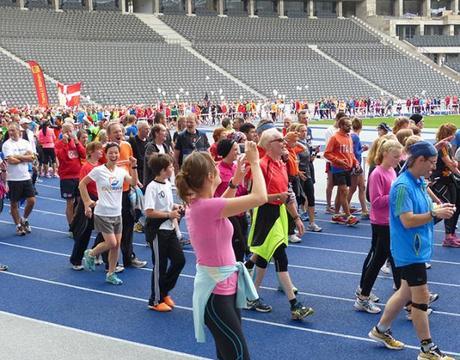
On the track at Olympiastadion… “Heads up, coming through, mad sprint to the finish!!!”
Saturday evening we gathered at the hotel Sofitel Berlin Kurfürstendamm for the Marathon Tours pre-race pasta dinner. There we topped off our carb stores and listened to guest speaker Tom Grilk, Executive Director of the Boston Athletic Association. He talked about the B.A.A’s response to the 2013 Boston Marathon bombings, as well as life in the immediate and long-term aftermath of the bombings. And he spoke humbly and appreciatively of all the runners who year after year make Boston the success that it is.
I was surprised to learn that only 85% of runners in the Boston Marathon meet qualifying standards (the other 15% presumably being charity runners), a number that seems awfully low given Boston’s prestige and its exclusive qualifying process. I’m all for running in the name of charitable causes, and did so myself in Chicago in 2012. But in the case of Boston, I’m also a strong proponent that qualifying standards should apply to ALL runners, particularly in light of the fact that the B.A.A. has had to turn away qualified runners in the past two years.
After dinner, with race number pinned to shirt and timing chip secured to shoe (really, Berlin? still using timing chips?), and with the next morning mapped out to avoid surprises, there was nothing left to do but call it an early night.
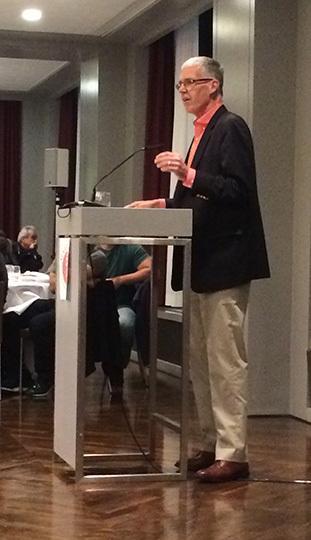
B.A.A. Executive Director Tom Grilk addresses the room at the Marathon Tours pre-race pasta dinner
With the new day comes new strength and new thoughts. – Eleanor Roosevelt
Early Sunday morning I awoke in the dark, convinced I’d heard my alarm and that it was time to rise and shine. My iPhone told a different story: 1:27 a.m.
Some time later I awoke feeling well-rested, wide awake and ready to roll, before my iPhone again burst my bubble: 4:40 a.m. So I lay in bed visualizing the day ahead and listening to the resonant hum of the city. Eighty painstaking minutes later, my alarm finally conceded what my brain and body already knew – it was go time. Berlin Marathon Day.
I donned my shiny new RaceRaves t-shirt (yes! you should click on that link and sign up), mixed the granola and yogurt I’d brought in an insulated pouch from California, and prepared my drop bag. Bidding super-spectator Katie farewell, I joined my fellow anxious runners on the bus destined for the giant Hauptbahnhof U-Bahn station, where I sat and ate breakfast as the compression-clad masses streamed toward the staging area. Soon I joined them – and that’s when an already edgy morning turned stressful.
With an 8:45 a.m. start time, I arrived in the Tiergarten staging area just before 8:00 a.m. and immediately hopped in line for the port-o-lets. And there I stood 40 MINUTES LATER, as the ten available units were forced to serve literally hundreds of runners. This was an indefensible screw-up on the organizers’ part, and my stress levels soared as I watched other runners finish their warmups and head toward the start line. Adding insult to injury, by the time I reached the front of the line, my unit was out of toilet paper. Luckily years on the trails have taught me always to carry my own supply, though I doubt the people after me were so lucky. And there were plenty of runners still in line when I exited the overworked unit at 8:43 a.m.
Hurriedly I handed my drop bag to the teenage volunteer and jogged toward the start line, hearing the distant sounds of the starting horn sending the runners in my corral on their way. Finally reaching the start line a couple of minutes later, I slipped in at the front of the next shoulder-to-shoulder wave. With the Brandenburg Gate rising imposingly behind and the Victory Column looming straight ahead, I positioned myself three feet behind the most important start line of my running career to await the starter’s countdown.

Almost missing Katie at the 7-km mark
Don’t watch the clock; do what it does. Keep going. – Sam Levenson
The first half of the race passed smoothly, other than my usual energy lull between miles 8 and 11. Every once in a while I’d look up to see another km marker ahead (the 42 separate km markers were significantly more than the 26 mile markers I’m used to), and every so often we’d run through a cloud of cigarette smoke or splash through the puddles of another aid station. And as my Garmin chimed to signal mile 13, my average pace held steady at 7:43/mile. Nice.
Turns out this was a good race to stay focused and block out distractions, since it’s not like I could read the spectator signage or understand most of the conversations going on around me. Other than the drawing of Yoda with German caption that I saw twice on the course, the only other sign I distinctly remember is the simply rendered black-and-white board reminding runners that “Finishing is your ONLY fucking option!” Well said, and way to showcase the subtleties of the English language!
My only nagging concern throughout the race was that, in wanting to ensure my unusually wide Altra shoes stayed snug on my feet, I’d not only tied them too tight but also double-knotted them. By the time I sensed them squeezing the tops of my feet like a vise, I refused to relinquish the minute or so I’d need to stop, untie, loosen and re-tie them. That minute could be huge in the big picture… so to compound my stupidity I chose instead to suck it up and check back regularly to ensure I could still feel my toes.
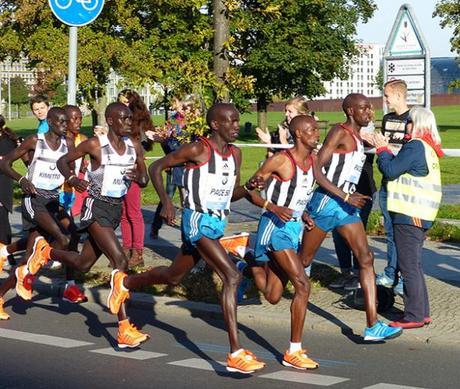
Dennis Kimetto and Emmanuel Mutai (rear), on their way to each breaking Wilson Kipsang’s world record
Approaching the 12 km (7.4 mile) mark I saw the Strausberger Platz Fountain ahead and noticed at the same time that the street before the fountain was soaked with water. My distracted brain immediately put two and two together and concluded the fountain was overflowing, before realizing that in fact I’d reached another aid station.
Unfortunately the race organizers chose to use plastic rather than paper cups at the aid stations, which may sound trivial but which meant the course was littered with cups and shards of plastic rolling underfoot. More than once I saw a runner stop momentarily to dislodge a cup that was stuck on his foot – just what you want to be doing at mile 19 of a marathon.
Twice (7 km and the halfway point at 21 km) I saw Katie along the course, and twice – thanks to crowd density and a limited field of vision – I’d nearly passed by before noticing her. Even at Chicago, a similarly sized race, I’d been able to locate her in the crowd and react well in advance of reaching her.
As the second half (i.e. the real race) began, I found myself dodging and weaving around slower runners to maintain pace – check out this glitchy footage of me and my fellow caravanners at 25 km/15.5 miles. On Berlin’s narrow streets and with spectators often spilling out into the street, the course seemed always to be congested, and I’d given up trying to run the tangents (i.e. the shortest and most efficient route). Twice I had to slow down to wait as a spectator cut in front of me, pulling a child across the street with him. And several times I heard an “Oop!” just as a runner cut me off trying to reach either an aid station or family members in the crowd.
One thing I realized in Berlin is that during a race loud music, raucous crowds and random noises have the opposite of their intended effect on me – they seem to siphon energy away, so that every time we’d pass a boisterous stretch I’d feel a wave of exhaustion wash over me. Several times on Sunday morning I found myself longing for a nice, quiet trail race.
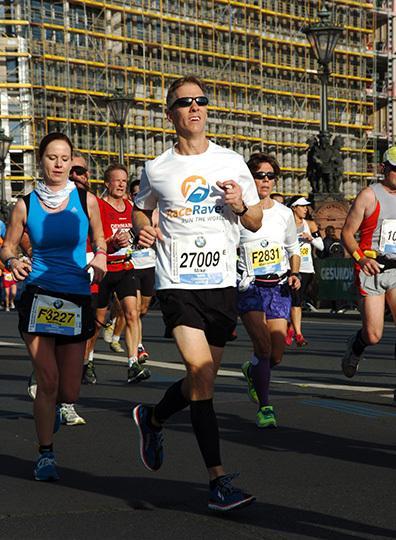
When I say RaceRaves was running ads in Berlin, I mean it literally
It’s always too early to quit. – Norman Vincent Peale
Inevitably all my dodging and weaving took its toll, and sometime around mile 18 I slammed into my own sobering version of the Berlin Wall. Like its real-life predecessor, the odds of getting over this Wall looked grim, as an extended bottleneck and mounting fatigue led to my first 8:00+ minute mile of the day (8:18). At that point my short-circuiting brain apparently thought it a great idea to share its negative scenarios, and disheartening images of my BQ goal slipping away began to flash before my eyes.
Slowing down now would be the death knell for my BQ chances, and if I gave in to fatigue then one slow mile would certainly morph into several slower ones. It didn’t help that the sun was now high in a cloudless sky… and though the course’s exposed stretches were brief, the sun’s 60°F heat was definitely at work.
But with 7+ miles still to go, I wasn’t ready to call it a day. In the months leading up to this race, I’d purposefully spent a lot of time visualizing positive outcomes. So quickly I popped a Clif Shot Blok (i.e. sugar bomb) in my mouth and refocused on picking up the pace. Luckily I still had a surge left in me, and mile 20 ended as my fastest mile of the day (6:51). Now my concern shifted to how much more I had left.
The marathon is a difficult undertaking and a daunting challenge under the best of circumstances. But just as the elites are running a whole different race than the rest of us, those who aspire to really race are running a different event than their fellow runners who are simply looking to finish and have fun doing it. I ran back-to-back marathons in Mississippi and Alabama earlier this year, with the goal of finishing each in a comfortable 3 hours, 45 minutes. Certainly I was tired after each race, potty-cularly given the circumstances in Alabama – but in both states I stopped at several aid stations along the way, and by the time I crossed the finish (at least in Mississippi) I could have run another few miles if necessary.
Berlin would be a very different story. The marathon doesn’t truly begin until your brain – i.e. your own worst enemy – gets involved, and its pessimistic chatter starts to remind you of how tired you are, telling you it’s ok to slow down a bit, you’ve gotta be hurting, you can’t possibly keep this up…
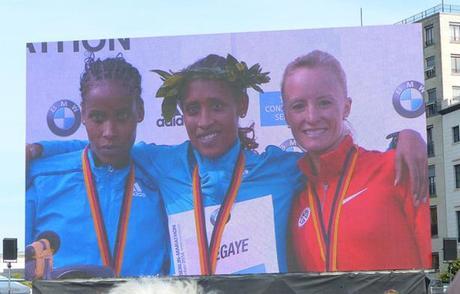
Shalane poses on the big screen with winner Tirfi Tsegaye (ETH) and runner-up Feyse Tadese (ETH)
Mile 22, and with the pealing of the Kaiser Wilhelm Gedächtnis-Kirche (Memorial Church) bells ringing through my haze, the remaining dregs of my mental reserves were laser-focused on maintaining leg turnover and cadence, to keep my mile paces as close to 7:45 as possible. Ask not for whom the bell tolls…
On the bright side, escalating exhaustion overpowered the acute pain on the tops of my feet.
With roughly 5 km (3 miles) to go I doggedly fell in step behind a red-shirted fellow with sweat flying off him whose pace matched my own, and I resolved to do whatever I could to keep him within striking distance. At mile 25 I glanced down at my Garmin, and was rewarded with the miraculous news that somehow, my average pace was holding steady at 7:43/mile. Desperate not to let it all slip away in the final 1.2 miles, I focused on anything and everything to distract from my leaden legs and mounting exhaustion – correct my wavering stride, pick off other zombified runners, visualize the Brandenburg Gate as always being just… around… the corner…
Until finally it was. Angels (maybe it was the winged figure atop the Gate?) sang on high as this time the raucous cheers of thousands of spectators propelled me along the final stretch, one of the most “WOW”-ly historic stretches of race course in the world. Overcome with the emotional realization that this is it, weakly I threw up my arms as I passed through the Gate and saw…
… the finish line, still 400 yards dead ahead. 400 very. long. yards. Feeling like a rusted old jalopy running on fumes and leaking oil with every step, I dug down as deep as I could for one last surge – and came up empty. I had nothing left. No final surge, no proud sprint to the finish – only muscle memory and a few carefully hoarded molecules of ATP carried me those final 400 yards and across the finish to where the happy people waited.
Shakily I wobbled to a stop, threw back my head and gulped down a few deep breaths as I stared at the sky in dazed disbelief. Meanwhile, the MarathonFoto folks positioned above the finish line looked beyond me as though to indicate “OK buddy you’re done, move it along, more interesting runners to photograph here.” Happily I obliged.
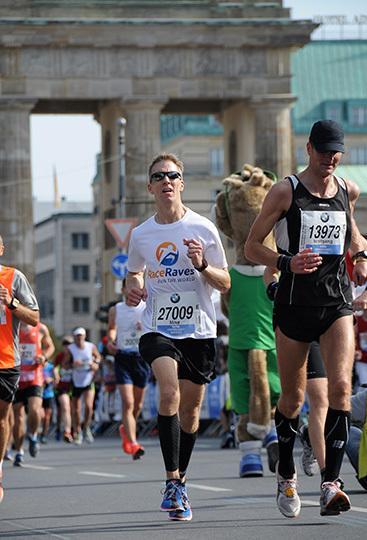
On the shiny happy side of the Brandenburg Gate
High expectations are the key to everything. – Sam Walton
Glancing down at my Garmin, I was elated to see the number I’d hoped for – average marathon pace, 7:44/mile! Beeping over to the next screen, though, my elation wilted as my Garmin stoically displayed an overall time of 3:24:14, rather than the 3:22:30 (plus or minus) I’d expected to clock at that pace. Confusedly I checked again, and saw the number that made my still-pounding heart sink – 26.44 miles. Despite my best intentions of running the most efficient race possible, all the dodging and weaving around other runners had cost me to the tune of an extra ¼-mile.
To explain my chagrin: since the 2013 bombings, the number of qualified runners vying to run the Boston Marathon has outstripped the number of slots available (though again, if there weren’t so many charity slots set aside this wouldn’t be an issue). This means that some runners who achieve a qualifying time STILL will not get into Boston, and so the B.A.A. has instituted the practice of admitting only the fastest runners in each age group. In 2014, qualified runners actually had to run 98 seconds faster than their qualifying time to get into Boston, and for 2015 the number dropped to 62 seconds. Based on these re-jiggered times, besting my qualifying time of 3:25:00 by a mere 42 seconds won’t cut it for 2016.
So to bottom-line this convoluted tale – YES I did qualify for Boston, but NO I probably won’t get in (though I might) based on my Berlin time and two years of Boston precedents. Talk about bittersweet. And to make matters more bitter than sweet, if I I’d hammered out just one more 7:45 mile rather than the 8:10 I clocked at mile 26, I would have beaten my qualifying time by 67 seconds and put myself in much better (though still tenuous) position for Boston 2016.
Then again, as my high school basketball coach used to say to what if scenarios, “If your aunt had a package she’d be your uncle” (he was kind of a philosopher-coach). What ifs aside, I’m determined to turn gators into Gatorade here – now that I’ve broken 3:25:00, I know I can run an even faster marathon. And as much as I would have loved to score a PR and qualify for Boston at the same time (and admittedly threaten Dan’s solid PR of 3:23:12 in the process), I do understand the importance of baby steps. But that doesn’t mean I like it.
So in the final analysis, Berlin will go down in my marathon catalog as lucky #13 – I worked my way from PF (plantar fasciitis) to PR (personal record) in less than four months and qualified for Boston in the process. And my body felt great doing it. Along the way we reunited with old friends, made new ones and parted with an eye toward future reunions (see y’all in NYC!). All adding up to a kick-ass time in a kick-ass city. Now I’m confident that the extra motivation gained from my Berlin experience will keep my training focused and ultimately get me where I need to go. That being the start line in Framingham in April 2016.
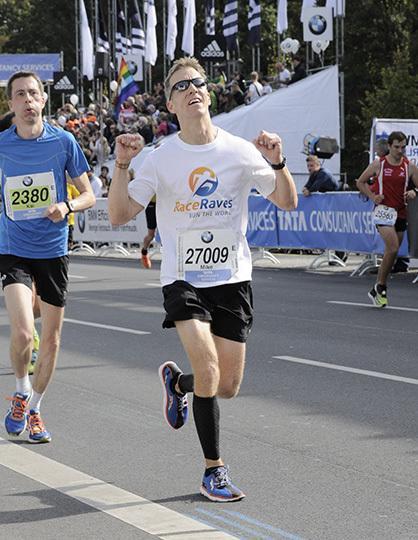
Thanks to the fellow behind me for blowing me across the finish line
Ich bin ein Berliner. – John F. Kennedy
Some runners care little for race bling, while others outright scoff at the idea. But I have to admit that after 13 marathons, accepting that finisher’s medal from a friendly volunteer never gets old… and the moment always fills me with endorphin-fueled appreciation, for my own performance as well as for all those who helped me get to the finish. Each medal hanging on my wall at home recognizes the collective efforts of a largely nameless and faceless support crew – plus of course Katie, always the most important member of that crew.
Coincidentally, the flip side of the 2014 Berlin medal pictures Wilson Kipsang, whose 2013 Berlin world record (2:03:23) lasted one short year before falling to fellow Kenyans Dennis Kimetto (2:02:57) and Emmanuel Mutai (2:03:13). Their record-setting duel fired up the running community and re-ignited the Holy Grail debate over the imminence of a sub-2 hour marathon. Great job guys, and enjoy your nine months of “LAST CHANCE TO ORDER!” emails from MarathonFoto.
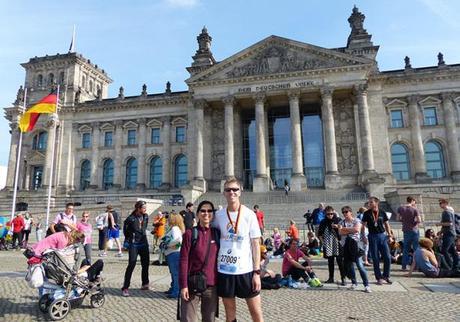
Out of the way you two, you’re blocking a sweet shot of the Reichstag building!
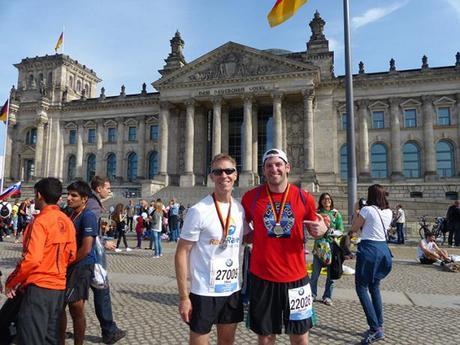
Catching up with a victorious Otter… luckily that finger wasn’t loaded
Meanwhile, only one American (Fernando Cabada, 11th overall) finished in the top 50. Five zero.
And though no world records were set on the women’s side, Shalane Flanagan again muscled up for the U.S., earning third place by running the second-fastest marathon ever by an American women (2:21:14, behind only Deena Kastor’s 2:19:36 performance at London in 2006). Huge congrats to Shalane… her 2014 will be a tough year to beat.
Entering the finish chute I could finally collapse on the curb and loosen my shoes, as by now my badly bruised feet and shins were screaming at me. Apparently 43 years hasn’t been enough for me to learn how to tie shoelaces. Aside from cutting off my circulation though, the Altra The One2 shoes I wore worked out great. Every race really is a learning experience.
With the post-race heat sheet draped around me like Superman’s cape, I hobbled a significant distance through the finish chute before reaching the first water station. There I was shunted to another station after being told the water was for medical emergencies only. Finally quenching my thirst, I glanced around in search of post-race munchies. Disappointed to find nothing more substantial than apple slices and bananas (and no thank you to alcohol-free beer), I hustled out of the chute and happened to spy Katie as we both converged on the grassy front yard of the Reichstag. From her final post alongside the Brandenburg Gate, she’d had to circumnavigate the entire perimeter of the finish area before reaching the family reunion area, where we now settled down to soak up the sun.
As we compared notes and shot photos, I kept one eye on the steady stream of runners exiting the finish chute. As unlikely as it seemed in a crowd of 40,000+ people, I was on the lookout for a familiar (I have one of my own) red 2012 Chicago Marathon shirt. Sure enough, my persistence paid off when I glanced up to see Otter and several friends in animated conversation heading our way. In a scene that’s quickly becoming a cool “destination race” tradition, Otter and I congratulated each other (he’d run his first sub-4 marathon in nearly a year), immortalized the moment and made plans to meet the next day. Which we did. Given that we’ll both be running NYC in three weeks, I’ll be scanning the crowds in Central Park in the hopes of keeping this tradition alive.

“Prost!” to a race well run, with fellow traveling runner (and Bay Area native) Herzel
At that moment, sunning myself lazily on the lawn of the Reichstag amidst a rainbow of nationalities and with unfamiliar languages swirling around me, I heard JFK’s decidedly non-Germanic accent in my head: Ich bin ein Berliner. At that moment, beaming runners from North America, South America, Africa, Asia, Europe and Oceania all proudly sported the same finisher’s medal hanging from the same black, red and gold ribbon around their necks. And at that moment, we were all Berliners.
Because while soccer may claim to be the world game, running is the world sport. Unlike other competitions, where our team plays your team and our fans sit across the stadium from your fans, running brings everyone together at the same time and on the same playing field. Nothing says “Maybe we CAN all get along” like 56,000 athletes from 130 countries all moving in the same direction toward a common goal, like sneaker-clad iron filings toward a magnet. More than anything else, this is what the World Marathon Major is all about. Berlin 2014 showcased the spirit and camaraderie of the international running community, and I was both psyched and privileged to be a middle-of-the-pack part of that.
And speaking of international events, it’s time I started tapering for New York…
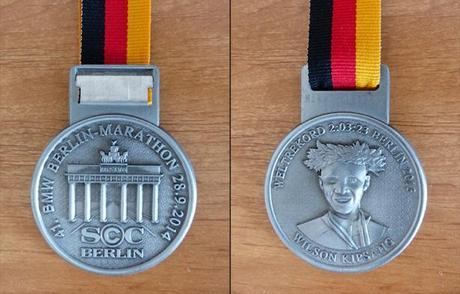
BOTTOM LINE: “Flat and fast” is the phrase most often used to describe the Berlin Marathon, and I’d agree with the first part of that – the course is flat for everyone. And in all fairness, its obscene flatness does make it faster than just about any other marathon course out there – even the Chicago Marathon has “Mount Roosevelt” lying in wait at mile 26. But Berlin’s fastness is deceptive because as flat as the course is, unless you’re an elite it’s also among the most crowded courses you’ll ever run (stay tuned for NYC in three weeks). And it’s crowded for pretty much the entire 26.2 miles, with Berlin’s narrow streets allowing for only occasional stretches of comfortably uncongested running.
So race day felt a bit like an extended cattle drive, and race production – especially for a world marathon major – was surprisingly subpar (see below). But if you’re a hardcore runner, it’s doubtful anything I write will discourage you from running Berlin. In some ways it feels as though the organizers are saying, “Hey, if you want to go run a DIFFERENT world marathon major, be our guest.” They know they have a captive audience of rabid runners with bucket lists written in blood, and that runners looking to run all six majors will dutifully line up each year to throw their name into the Berlin lottery hat.
And honestly, I wouldn’t want to discourage anyone from running Berlin, if for no other reason than to experience and immerse yourself in one of the world’s most historically and culturally amazing cities. Despite my wanting to curl up and sleep under it by that point, running through the Brandenburg Gate at mile 26 was an indescribable thrill, and moments like that are a major reason I love running the world. I just wish the organizers would listen to runner feedback, or that the other world marathon majors would implore Berlin to step up its game. Because as epic a race weekend as this was, a few tweaks could have made it so much better.
PRODUCTION: I can only imagine how challenging it must be, and how much choreography and security must be involved, to organize and stage a marathon the size and gravitas of Berlin. With that in mind I tip my cap to the organizers, since to a person every runner I spoke with had an overall positive experience.
That said, race production is where Berlin fell short on many levels. In comparison to the only other marathon major I’ve run so far, Chicago 2012, Berlin was a disappointing second. And these aren’t the isolated grievances of one bitter runner who did-but-didn’t qualify for Boston – many if not all of these issues were echoed by other runners:
- The expo was TOO FREAKING HUGE, and was more like a trade show than a race expo. It’s a pretty clear indication your expo is out of control when it expands to fill several hangars of a former airport. Unlike U.S. race expos there were scarcely any free samples to be had… every item seemingly carried a price tag, and even the normally generous PowerBar peeps were carefully guarding their electrolyte drink station. What’s more, the expo was a harbinger of things to come on race day as I felt inexorably herded in different directions, first to access each separate hangar, then to enter the bib pickup area, then to exit the bib pickup area, then to traverse (how convenient!) the Adidas storefront hawking official race merchandise, and finally toward the ausgang (exit).
- And on the topic of the Adidas storefront, as absurd as it sounds in 2014, Berlin race registration includes NO race t-shirt – though official race shirts were available at the expo for the {ahem} bargain price of 30€ (= $39). Do a quick calculation, and you can estimate how much money the organizers must be a) saving by not providing t-shirts, and b) raking in by charging for shirts.
- Re: the pre-race setup, I arrived one hour beforehand and waited in line for ~40 minutes to use one of the ten port-o-lets that were serving literally hundreds of anxious runners. This was horrific planning by the organizers, and was by far the most stressful part of race weekend – even the much smaller (and more well-organized) California International Marathon, which I ran in 2011, had roughly 10x the number of units as Berlin. Not only that, but when I finally reached the front of the line my port-o-let was out of toilet paper. And to top off my pre-race cortisol levels, I completed my harried pit stop two minutes before my wave was scheduled to depart, and had to hurriedly jog another ¼-mile (at least) to reach the start line where I barely arrived in time to join the corral departing in the wave after mine. Damn, I’m getting stressed out all over again just writing this.
- Luckily I took advantage of only one aid station on the entire course, so I don’t have much to report about their frequency or offerings. But I couldn’t avoid noticing that the organizers chose plastic rather than paper cups – an unfortunate choice since plastic cups ended up bouncing underfoot at every aid station, as runners were forced to expend energy sidestepping carefully to avoid getting their foot caught in one. Note to organizers: next year, when your supplier asks “paper or plastic?”, do the right thing and answer “PAPER”.
- The post-race spread was abysmal, and in fact I walked what felt like several hundred yards through the finish chute before even reaching the first water station (at which point I was shunted to another table, since that water was only for medical emergencies). And with apologies to Erdinger, their sponsorship was a big ol’ letdown. I don’t think it’s unreasonable to expect that, after running a world marathon major in Germany’s largest city, the word “free” should fall before rather than after the word “alcohol”. Chicago after all had free-flowing real beer (thanks, Goose Island!). Alcohol-free beer after the Berlin Marathon felt like having your picture taken with a cardboard Mickey Mouse cut-out at the Walt Disney World Marathon.
- Food-wise, the only offerings I could see were apples and bananas, with no obvious source of protein – ironic, considering that even the 6K fun run Katie had run the day before had provided its scarcely winded finishers with both regular and chocolate milk. Later I realized that the not-so-goodie bag handed out by volunteers in the finish chute (why do I need another goodie bag?) contained a PowerBar wafer product, which like so many of their products over the years held true to the PowerBar ethic of falling just this side of “Soylent” on the palatability scale. Accordingly, I gave up after two nibbles.
FINAL STATS:
September 28, 2014
26.44 miles in Berlin, Germany (continent #3)
Finish time & pace: 3:24:14 (first time running the Berlin Marathon), 7:44/mile
Finish place: 4,044 overall, 921/4,218 in M(40-44) age group
Number of finishers: 29,021 (22,226 men, 6,795 women)
Race weather: clear and calm (starting temp 52°F)
Elevation change (Garmin Connect): 485ft ascent, 488ft descent

My tightest marathon splits to date: 1:42:00 for the first half, 1:42:14 for the second half
